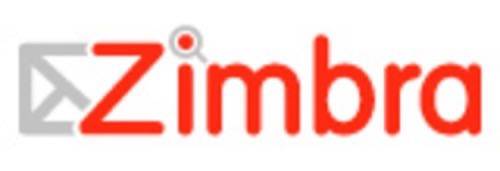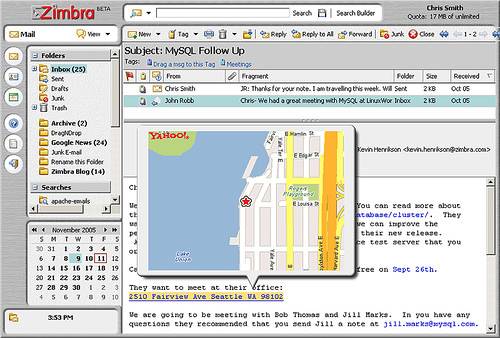This week Zimbra was acquired by Yahoo! for a staggering $350M. It seems like only yesterday that Zimbra was the buzz of the 2005 Web Conference. But in two years, Zimbra has grown from a small ‘cool features’ startup to a company worth $350M. But why did Yahoo buy a Web Office collaboration suite? Last time I checked, Yahoo was a consumer-focused Internet company – not an enterprise or business one. How can Zimbra be used by Yahoo’s target audience, or integrated within Yahoo’s current product line-up? This post tries to answer those questions.

From 2005 Web 2.0 Poster Child to 2007 Success Story
A little history about Zimbra – it is an email and collaboration suite that uses Ajax and mashups on the front-end to achieve a slick new form of collaborative email and calendering. When it was unveiled in October 2005, the Zimbra Collaboration Suite was described as an “open source messaging server and client ” and it aimed to “fundamentally change the way people interact with e-mail”. Some people said it was an alternative to Microsoft Exchange. In 2005 they were big dreams – and it certainly captured the imagination of the Web 2.0 Conference attendees and bloggers.
I was at the 2005 Web 2.0 Conference, although my post on Zimbra’s presentation at that time was just some quick notes. But in February 2006 I named Zimbra my best-of-breed ‘mini-suite’ at that time. Then in my first in-depth review of Zimbra in April 2006, I noted that the biggest promise in Zimbra was in its mashups:
“The real power of Zimbra is its APIs, which together with ZimbraÄôs open source status makes this a potentially powerful development platform. The APIs enable developers to access messaging functions inside the Zimbra application, meaning external apps can hook into ZimbraÄôs functionality. The example used in the demo is a travel application using ZimbraÄôs APIs to “automatically create a calendar event for the person traveling”.”
And that is probably one of the main reasons why Yahoo acquired Zimbra. Yahoo is aiming to create a more open platform, using APIs and mashups across multiple Yahoo properties (e.g. Yahoo Maps). Yahoo executive Brad Garlinghouse wrote in a post this week that he sees “great opportunities to incorporate some of their [Zimbra’s] best-of-breed features (I really like their calendaring) into Yahoo!Äôs industry-leading communications products.” But it’s not just Yahoo’s comms products that will benefit, it’s basically anything with an API – and Yahoo has a lot of APIs, including for Y! Mail.
Note that in mid-2006, Zimbra had problems with performance in IE browsers – which came about because it’s always been pushing the envelope of Ajax. However that was more of a browser issue than Zimbra’s fault.
Pic by ttaulli

Yahoo/Zimbra vs Google
It’s fair to say that it was the frontend (Ajax, mashups) that wowed Web 2.0 Conference attendees about Zimbra in 2005. However the backend is very stable and it has all the main features that make it acceptable for use by Fortune 500 companies (who are among Zimbra’s customers today). Here’s how the backend was described in Zimbra’s 2005 press release:
“…the collaboration server integrates search, archiving, discovery, anti-spam and anti-virus/security features into a single messaging platform which is able to support a company’s current network and end-user experience.”
But to the question: why did Yahoo acquire business software? By acquiring Zimbra, Yahoo has in a sense entered the Web Office space. Yahoo may be aiming at the small business market, particularly as Zimbra gives them a very strong email/calendar solution to add to their already technologically-sound Yahoo Mail offering. Remember that Yahoo Mail already resembles Outlook in look n’ feel, so adding Zimbra to the mix makes for a strong web mail offering, which small businesses and other organizations can utilize.
In terms of how this positions Yahoo/Zimbra against Google Apps, the leading Web-based competitor to Microsoft Office, Zimbra’s competitive advantage against Google is that it’s open source and downloadable. The fact that Google’s products have to remain behind Google’s firewalls put it at a disadvantage to a product like Zimbra, which can be set up on any company’s servers. Also, if you recall, last week Read/WriteWeb ran a story about Zimbra’s Sarbanes-Oxley compliance alert against Google Apps. Although several commenters came to Google’s rescue, the fact remains that Google Apps (and Zoho for that matter) have more of a challenge meeting security and compliance issues, simply because they aren’t hosted in-house on the client’s premises.
Conclusion
The acquisition this week of Zimbra may be cosidered expensive for Yahoo, but it shows their long term commitment to technology (the 2 new hacks products we reported on last week also show this) and a willingness to look for new markets.
Yahoo will probably never be a full enterprise software company, as Google wants to be, but there is a lot of potential revenue in an email/calendar suite for small businesses and consumers in general. Could it be that back in the hands of Jerry Yang, Yahoo is turning back to its roots and competing as a technology company again? With Zimbra on board, they have certainly fortified their web tech artillary. Also I’m looking forward to seeing how Zimbra is integrated into Yahoo’s vast product range – not just email, but in many other ‘hacks’ as well.
I wrote in April 2006 that Zimbra is “an all-round impressive product and one can only wonder what such a feature set would be able to achieve on a large scale – for example if Google bought Zimbra!” Well, I was wrong about who acquired it – but I’m still itching to see what a bigco does with Zimbra!
Additional analysis in this post was contributed by Emre Sokullu
Related Articles:










